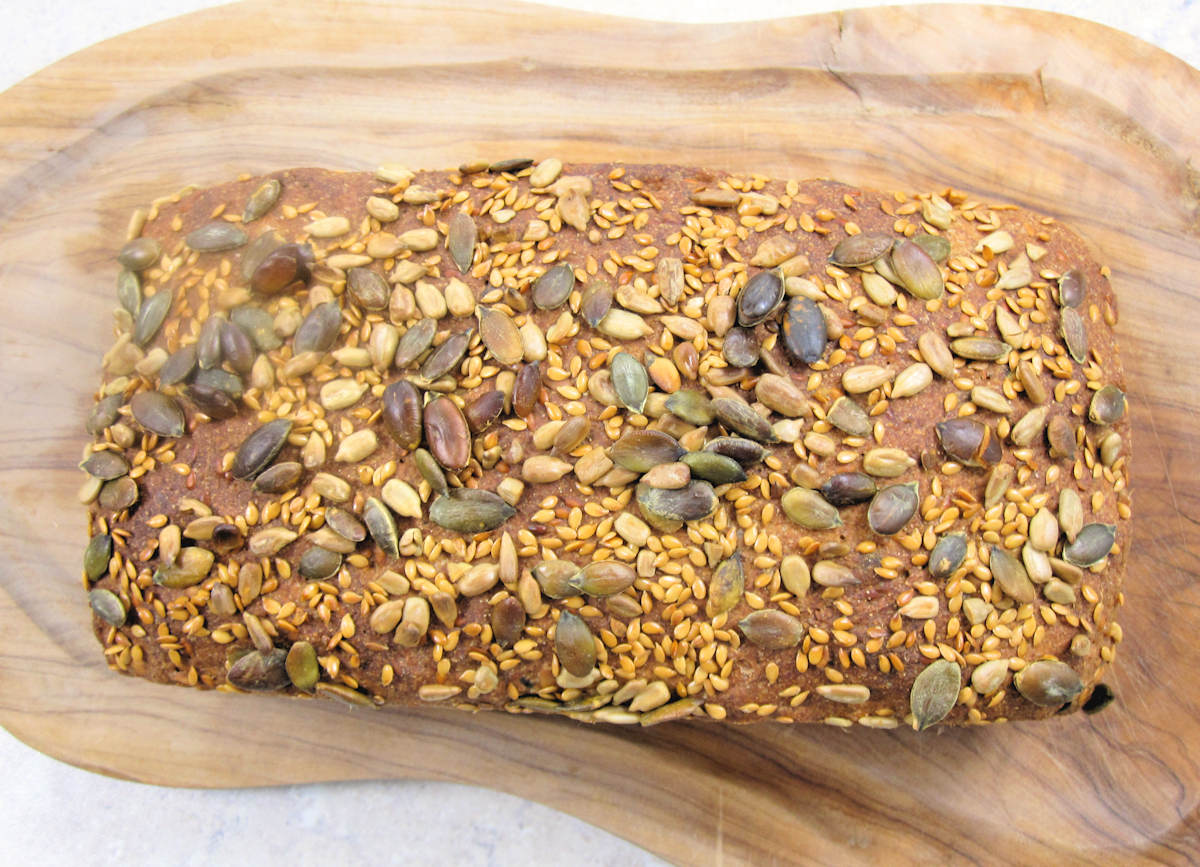Seeded rye bread, easy to bake in an afternoon, best on the next day and fantastically good for gut health. It goes with cream cheese or fish pate, or just a lick of butter and honey.

Rye vs. wheat bread
Rye bread is a totally different story than wheat. Where wheat bread is fluffy, rye is stodgy. While white loaf is crusty, rye is practically all crumb. Wheat is best fresh; rye has to stand overnight in order to even slice it neatly.
A thick and thickly buttered slice of wheat bread vs. a paper thin wafer of rye with a smudge of butter. Rye bread won’t tolerate fancy sandwich fillings and will even object to being sandwiched – open top is the only way to go.
It is grim, stodgy, dense and not a little miserable.
Rye bread is good for your gut!
But it's hugely refreshing to bake and eat every now and then bread that is dissidently different. Rye is also wonderful for gut health and more tolerable for people sensitive to gluten. Plus all those seeds in this particular recipe: it's a true massaging brush for the gut!
Rye bread keeps well too; in fact it keeps so well it's better eaten after twenty-four hours. Rye bread needs to settle after baking: straight from the oven it will be impossibly crumbly and a little dry.
Once you have acquired a taste in rye breads, you must try rye sourdough. The naturally fermented version of this loaf is my seeded rye sourdough and it's glorious.
You might also try your hand at the Tsar of rye breads: borodinsky. But it is a bit of a challenge.
What is seeded rye bread like?
Dan Lepard, whose old recipe from The Guardian inspired me, says it’s a little like a blonde pumpernickel but I think it doesn’t have the pumpernickly sourness. It's lighter too with the addition of some wheat flour: a little wholemeal and a little white.
I love it sliced quite thinly, with butter and honey. It obviously goes extremely well with pastrami and gherkin, or salt beef and mustard. Any fishy toppings are excellent too: cream cheese and smoked salmon, crab paste or potted mackerel. Scandinavians, after all, do know a thing or two about rye smörgåsbords.
Seeded rye is easy to make
Making the dough is really no different to making mud cakes, and it resembles them too. No need for a mixer or food processor: you can use a wooden spoon or your hands.
After a statutory first proof, shape the loaf with your hands dabbed with water. Butter the loaf tin: rye dough tends to stick more than wheat and hard fats create a better non-stick lining for the tin.
There is a considerable amount of yeast in the dough so the final proof should not be longer than an hour; or until the dough has risen almost to the rim of the tin. It bakes in a medium-hot oven, fan assisted if possible, turning the heat down a little for the last quarter of an hour.
It will emerge, smelling so gorgeous that it will be hard indeed to let it rest until the following day without sampling. But trust me - it will taste all the better for waiting.
More rye bread recipes
Malt vinegar rye bread with coriander and caraway seeds, nearly as exquisitely tasty as rye sourdough which it pretends to be, with a fraction of the toil.
Easy deli style homemade rye bread leavened with yeast: it is perfectly possible to make deli style bread without a sourdough starter. Great for sandwiches and excellent for toasting.
Savoury courgette wheat and rye bread with Parmesan, it is excellent for slicing, buttering, and turning into ham sandwiches.
More seed recipes
Roasted seed and nut mix, a perfect topping for salads, toasted in a warm oven. Salty and crunchy clusters of seeds and nuts are the best addition of fibre and essential nutrients to your diet.
Crunchy seed crackers made with a mix of seven seeds; gluten free and keto-friendly if you skip millet grain. Great as a snack, broken over a salad for a topping, or served on a cheese board.
Pear and grilled halloumi salad with roasted parsnip and salty pumpkin seeds. Everything is there: the wholesome, the sweet, the salty and the crunch. A perfect salad? I think so!